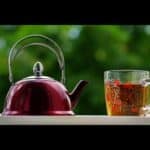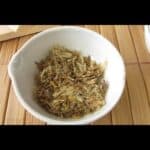The Benefits and Drawbacks of Decaf Tea
Caffeine is found naturally in tea leaves. So, what do you do…
…if you want to drink a cup of tea before bed or if you are caffeine sensitive? This is where decaf tea comes into play. Most people understand that decaf tea does not contain caffeine. Most people are unaware of how tea is decaffeinated and what this entails in terms of health benefits. We’ll explain how decaf tea is manufactured and what it implies for you in this article.
Decaf tea, which is made from the blossoms, leaves, and roots of several plants, allows you to sip your favorite beverage without feeling wired or energized. Thanks to decaf teas, you may unwind with flowery blends or energize with stimulating mints at any time of day.
What Exactly Is Decaf Tea?
Decaf tea simply implies that there is no caffeine in the tea. This is useful for those who are caffeine sensitive or who wish to drink a tea before going to bed. It’s essential to note that depending on how it’s made, decaf tea may still have very low caffeine levels – more on that in a moment. Caffeine use can disrupt the sleep cycle and induce nausea, upset stomach, worsen acid reflux, and provoke headaches. Although all forms of tea can be decaffeinated, the most popular and frequently accessible varieties are black tea, oolong tea, and green tea from the Camellia sinensis plant.
Caffeine-Free vs. Decaffeinated Teas
While these two words are sometimes used interchangeably, there is a major distinction between caffeine-free and decaffeinated teas. Caffeine-free teas have no caffeine, whereas decaf teas include caffeine that is afterwards eliminated in order to appeal to a larger audience. Decaffeinated tea differs from naturally caffeine-free teas in that it contains trace levels of caffeine. Decaffeinated tea often includes 2 milligrams of caffeine since the decaffeination procedure cannot completely remove it.
Caffeine content varies based on the method used for decaffeination and the quality requirements of the firm that removes caffeine from tea. Caffeine-free teas have no caffeine because of their natural makeup. Caffeine-free teas are often herbal teas or tisanes like jasmine tea, chamomile tea, and mint tea. Caffeine-free herbal teas, such as chamomile, are popular night drinks because they have a natural soothing effect.
How Does Tea Get Its Caffeine?
There are Four Distinct Decaffeination Methods
So, how does one extract the caffeine from tea? There are four main ways for extracting the naturally occurring caffeine from tea leaves. There are techniques that make use of chemical solvents, carbon dioxide, and water. Each method works somewhat differently and has a distinct impact on the flavor and consistency of the tea.
CO2 (Carbon Dioxide)
Carbon dioxide is the most natural technique of decaffeination, and it is used by international companies such as Hag and Harney & Sons. This technique is also the most effective in preserving the flavor characteristic of the tea while removing the caffeine level without affecting any possible health benefits. This process is nontoxic and typically more costly, but it is the most effective in preserving the tea’s content.
High pressure and high temperatures are applied to tea leaves until the carbon dioxide reaches a condition known as the super-critical state. At this moment, the carbon dioxide reacts with the caffeine molecules in the leaves to produce a solvent. Because the flavor molecules in the leaves are bigger than the carbon dioxide and caffeine molecules, this decaffeination technique has no effect on them.
Acetate of Ethyl
Because this molecule occurs naturally in tea leaves, the technique of eliminating caffeine by employing ethyl acetate is typically described as “naturally decaffeinated.” This is a common procedure since it is less harmful and less expensive than alternative ways, however it is known to change the flavor profiles of tea.
To eliminate the caffeine, tea leaves are steeped in ethyl acetate. It is quite hard to extract the ethyl acetate from loose tea leaves once the caffeine has been removed. As a result, the flavor is changed, and it is frequently regarded as having a chemical or bitter taste.
Chlorine Methylene
This technique is similar to ethyl acetate, except the caffeine is extracted using a different chemical. Tea decaffeinated using this method retains more of its original taste character than tea decaffeinated using ethyl acetate. However, residual quantities of methylene chloride, a toxin related to cancer and birth abnormalities, may still exist. Some nations prohibit the importation of teas decaffeinated in this manner, and the European Union has set restrictions on the quantity of residual methylene chloride allowed in teas. The FDA governs the use of this technique in the United States.
Water Treatment
This technique is more commonly used to decaffeinate coffee beans, although some tea companies utilize it to decaffeinate loose leaf teas as well. To eliminate the caffeine, the tea leaves are steeped in water and then put through a carbon filter. The water is then reintroduced to the tea leaves in order to produce taste. The water technique frequently produces watery tastes and does not preserve the strength of breakfast black teas or other strong teas effectively.
Was this helpful?
Hi there! I’m a food enthusiast and journalist, and I have a real passion for food that goes beyond the kitchen. I love my dream job and I’m lucky enough to be able to share my knowledge with readers of several large media outlets. My specialty is writing engaging food-related content, and I take pride in being able to connect with my audience. I’m known for my creativity in the kitchen, and I’m confident that I can be the perfect guide for anyone looking to take their culinary journey to the next level.








